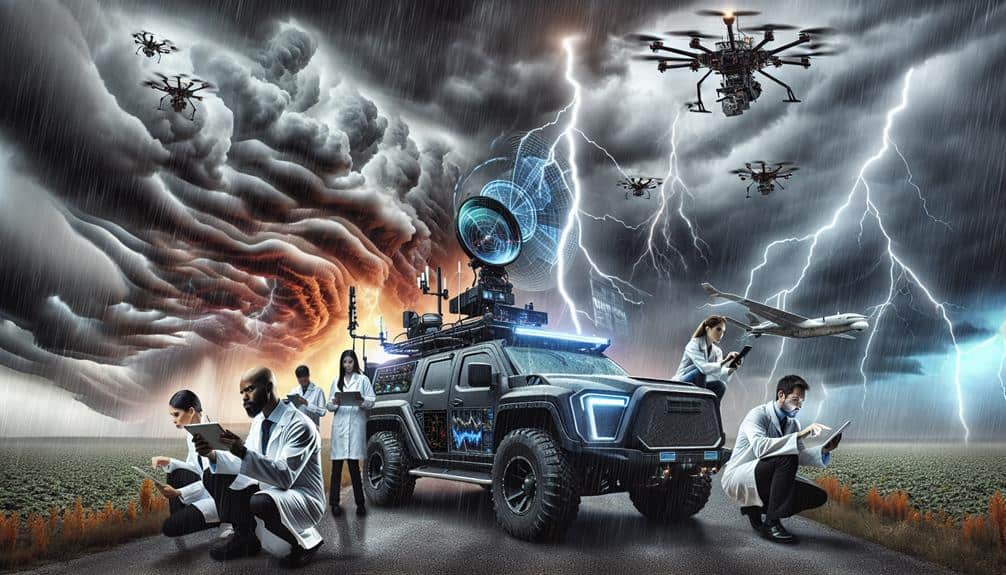Analyzing atmospheric data in real time involves leveraging anemometers, barometers, and hygrometers for precise measurements, complemented by satellite imagery and ground sensors for thorough data collection. We integrate cloud-based analytics for scalable, cost-effective processing and use mobile applications for real-time data access. Advanced visualization software transforms complex datasets into understandable, interactive graphs, enabling us to make informed decisions swiftly. Proper calibration ensures reliability, while cloud platforms enhance data accessibility and completeness. Together, these tools provide a powerful, real-time analytical framework essential for accurate weather forecasting and climate studies. Continue to explore how each component contributes to robust atmospheric analysis.
Key Points
- Utilize anemometers, barometers, and hygrometers for accurate real-time atmospheric measurements.
- Combine satellite imagery and ground sensors for comprehensive atmospheric data collection.
- Leverage cloud-based analytics to process and analyze vast amounts of atmospheric data efficiently.
- Access real-time atmospheric data via mobile applications with user-friendly interfaces.
Essential Instruments
To analyze atmospheric data in real time, we rely on key instruments such as anemometers, barometers, and hygrometers. These devices are the backbone of our sensing technology, enabling us to capture precise measurements of wind speed, atmospheric pressure, and humidity.
Accurate data collection is essential for making informed decisions, whether it's for weather forecasting, climate studies, or even agricultural planning.
Instrument calibration is an important aspect we can't overlook. Proper calibration ensures that our sensing technology delivers reliable and accurate data. An anemometer, for instance, must be calibrated to measure wind speeds accurately, which is crucial for predicting storm intensities.
Similarly, barometers require frequent calibration to maintain their accuracy in measuring atmospheric pressure, a key variable in weather prediction models. Hygrometers, which gauge humidity levels, also need meticulous calibration to provide valid readings.
We must maintain a rigorous schedule for instrument calibration to negate any discrepancies that could arise from sensor drift or environmental factors. By prioritizing calibration, we empower ourselves to harness the full potential of our sensing technology, guaranteeing that our atmospheric data remains precise and actionable.
This attention to detail grants us the freedom to act on reliable information, facilitating more accurate and timely interventions.
Data Collection Platforms
Leveraging meticulously calibrated instruments, we now turn our focus to the data collection platforms that aggregate and transmit this crucial atmospheric information in real time. These platforms include satellite imagery and ground sensors, both essential for thorough atmospheric analysis.
Satellites orbiting the Earth provide us with extensive coverage, capturing high-resolution images and data on various atmospheric parameters. Using advanced imaging technology, satellite imagery offers a macroscopic view of weather patterns, cloud dynamics, and pollutant dispersion. This data is critical for tracking large-scale phenomena such as hurricanes, typhoons, and atmospheric rivers. The precision of satellite data allows us to make informed predictions and respond swiftly to emergent weather conditions.
On the ground, an array of sensors complements satellite data by providing localized measurements of temperature, humidity, wind speed, and air quality. Ground sensors are strategically placed in urban, rural, and remote locations to ensure a thorough dataset. These sensors transmit real-time data to central databases, enabling us to detect microclimates and localized weather events that satellites might miss.
Cloud-Based Analytics
Cloud-based analytics enable us to process and analyze vast amounts of atmospheric data in real time, enhancing our ability to make accurate and timely weather predictions. By leveraging cloud infrastructure, we can scale our computational resources dynamically, providing the flexibility to handle peaks in data volume without sacrificing performance. This method is particularly advantageous for real-time processing, where the immediacy of data insights is essential.
Remote monitoring capabilities further expand our reach, allowing us to collect and analyze data from even the most inaccessible locations.
Here are four key benefits of cloud-based analytics for atmospheric data:
- Scalability: We can easily scale our processing power up or down based on current data influx, ensuring efficient resource utilization.
- Cost-Effectiveness: With pay-as-you-go models, we only pay for the resources we use, reducing unnecessary expenditures.
- Accessibility: Data and analytics are accessible from anywhere, providing the freedom to monitor atmospheric conditions remotely.
- Integration: Seamless integration with other cloud services enables us to combine data sources for a more thorough analysis.
Mobile Applications
In today's rapidly evolving technological landscape, mobile applications play an important role in providing real-time access to atmospheric data for both researchers and the general public. These applications harness the power of our smartphones to deliver accurate and timely data, enabling us to make informed decisions on the go.
We can't overlook the significance of a well-designed user interface in these mobile applications. A streamlined and intuitive interface ensures that users can quickly access the data they need without unnecessary complexity. This efficiency is vital for researchers who require real-time updates for their work and for individuals who rely on accurate weather information for daily activities.
Data accuracy is another essential factor. Mobile applications must integrate robust data sources and employ algorithms that enhance the reliability of the information provided. This guarantees that the atmospheric data we access is both precise and dependable, reducing the risk of misinformation.
In essence, mobile applications have democratized access to real-time atmospheric data, offering a blend of user-friendly interfaces and high data accuracy. This empowers us to stay informed and make decisions that align with our need for freedom and reliability in an ever-changing environment.
Visualization Software

Frequently, visualization software serves as an indispensable tool for analyzing and interpreting atmospheric data, transforming complex datasets into comprehensible graphical representations. With interactive graphs and a user-friendly interface, we can effortlessly explore intricate data patterns and derive meaningful insights.
One of the key advantages of modern visualization software is its capability to provide real-time updates. This guarantees that we're always working with the most current data, which is crucial for accurate analysis and timely decision-making. Additionally, the customizable features allow us to tailor the visualizations to our specific needs, enhancing both clarity and relevance.
For those of us seeking freedom in how we analyze and present atmospheric data, here are four essential features to look for in visualization software:
- Interactive Graphs: Enables us to navigate data dynamically, zooming in and out, and examining specific data points.
- User-Friendly Interface: Simplifies the learning curve, making it accessible for users at all technical levels.
- Real-Time Updates: Keeps our data current, reflecting the latest atmospheric conditions and trends.
- Customizable Features: Allows us to adjust the visualizations to fit our unique requirements, making the data more relevant and actionable.
Frequently Asked Questions
How Can Real-Time Atmospheric Data Improve Weather Forecasting Accuracy?
Did you know that real-time atmospheric data can boost weather forecasting accuracy by 30%? This improvement directly impacts agriculture, helping us optimize crop yields, and enhances emergency preparedness, ensuring we're better equipped for natural disasters.
What Are the Main Challenges in Real-Time Atmospheric Data Analysis?
The main challenges in real-time atmospheric data analysis include ensuring data processing efficiency and maintaining the accuracy of real-time updates. We must address these to provide reliable forecasts without compromising our need for timely and precise information.
How Does Machine Learning Enhance Atmospheric Data Interpretation?
Machine learning applications enhance atmospheric data interpretation by improving predictive modeling and accuracy enhancement. We harness these technologies to analyze vast datasets swiftly, offering precise insights and empowering us to make informed decisions with unprecedented freedom.
What Are the Ethical Considerations in Sharing Real-Time Atmospheric Data?
When we share real-time atmospheric data, we must address privacy concerns and guarantee data security. It's important to balance transparency with protecting sensitive information to empower users while safeguarding individual and national interests.
How Can Citizens Contribute to Real-Time Atmospheric Data Collection?
We can enhance citizen involvement in atmospheric data collection by utilizing crowd sourcing techniques. Individuals with smartphones and sensors can gather and share real-time data, empowering communities to monitor environmental conditions and promote transparency and freedom.


